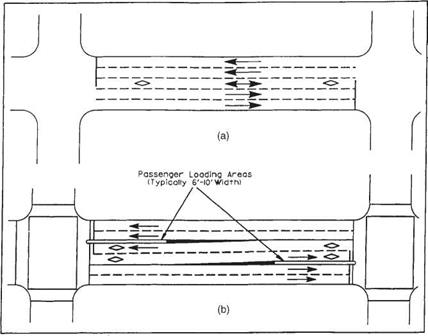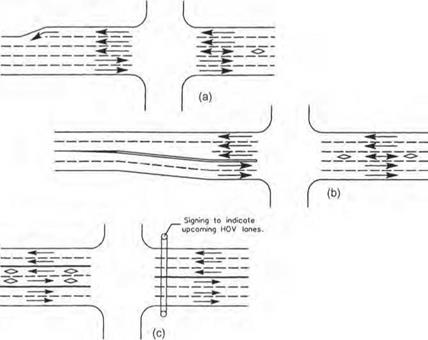HIGHWAY CONSTRUCTION PLANS
The purpose of a set of highway construction plans is to delineate the proposed work with sufficient design details, supplemented with notes, calculations, and summary of quantities, so that it can be clearly and uniformly interpreted by engineers and contractors (Ref. 8). Sufficient data must be provided to enable the contractor to make an intelligent bid and to perform the work as intended. Clarity, completeness, and
|
FIGURE 2.70 Examples of median HOV lanes for buses. (a) Reversible lanes for express buses. (b) Twoway lanes for local buses. Conversion: 6 to 10 ft = 1.8 to 3.0 m. (From Guide for the Design of High Occupancy Vehicle Facilities, American Association of State Highway and Transportation Officials, Washington, D. C., 2004, with permission) |
conciseness are essential so as to avoid misinterpretation. Unnecessary details should be avoided.
The original tracings serve as a permanent record of the project. They must be prepared on a material acceptable to the agency responsible for maintaining the plans as a record. A currently widely recommended material is the polyester film Mylar with a thickness of 4 mil (3 mil minimum), double – or single – (top side) matted. The surface should not be highly reflective. Only black ink should be used, although grid lines may be colored. Materials that are usually not acceptable include negatives, sepias, vellum, old sheets, dark background, pencil, paste-ons, stick-ons, or bond paper. Original tracings are usually about 22 by 34 in (559 by 864 mm). The designer should prepare the plans keeping in mind that the drawings will most likely be reduced to quarter size (i. e., 11 by 17 in or 280 by 430 mm) prior to distribution.
More and more agencies are switching over to an electronic plan submission. With the overwhelming use of computer-aided design and drafting (CADD) applications, many agencies, large and small, are expressing a preference for plans developed by CADD software. Although paper prints are still necessary as part of the plan development and construction process, the official filing of Mylar or similar media is being replaced by filing of computer disks that contain design files, including images of plan sheets that can be easily viewed on screen or printed as necessary.
|
FIGURE 2.71 Typical transitions for median or center lane HOV. (a) With reversible HOV lane and outer transition. (b) With reversible HOV lane and inner transition. (c) With two one-way HOV lanes. (From Guide for the Design of High Occupancy Vehicle Facilities, American Association of State Highway and Transportation Officials, Washington, D. C., 2004, with permission) |








Leave a reply